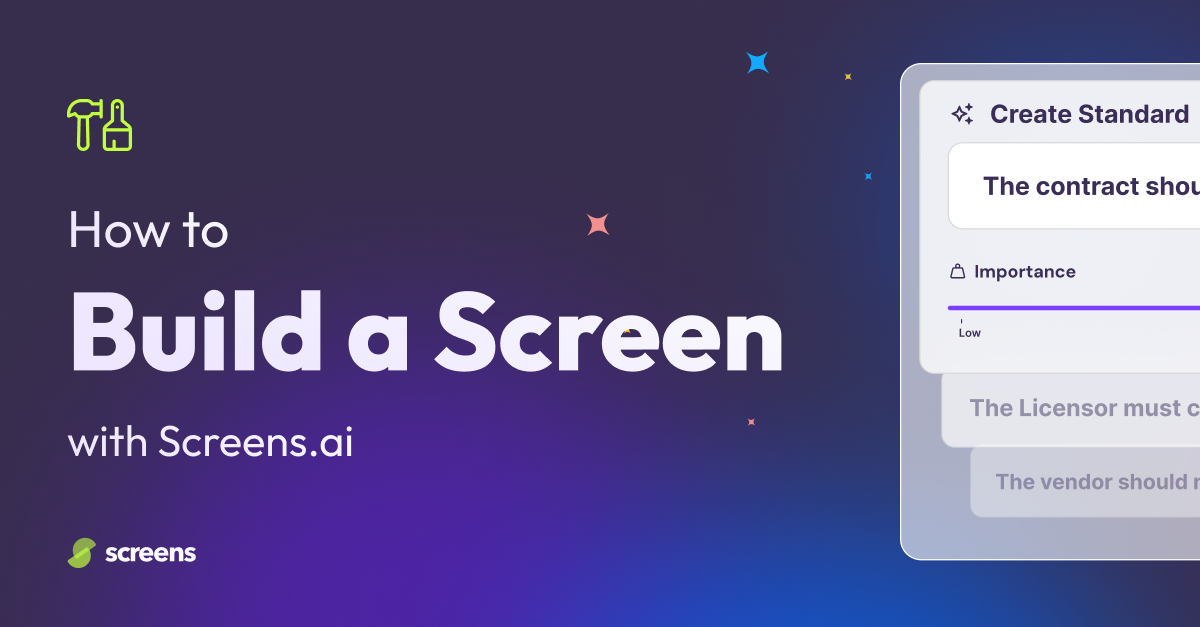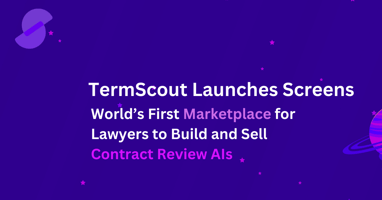How to Build a Screen with Screens.ai

Note: this article focuses on the drafting and prompt engineering aspects of creating a great screen. The mechanics (e.g. where to go in the app, what buttons to click, etc.) are explained in this video.
Turning your contracting requirements into Standards should and can be a simple exercise. There are some nuances and considerations to be aware of when drafting your Standards. A little work upfront will set you up for success. Before we dive in, though, it's important to understand what makes up a Standard.
Standards are made up of three components:
- Standard: the requirement or condition that must be met.
- AI Guidance: additional information can be added to explain any nuances or considerations related to the Standard. AI Guidance impacts the results returned.
- User Guidance: used to explain to users why the Standard is included in the screen, what to do if it fails, or other internal guidance. User Guidance does not impact any results.
Considerations before drafting
Think about the use case for your screen. Are you planning to do a bulk review, upload documents to the screens app, or redline in Word? You can of course use the same screen for each of these, but thinking about your ideal outcome and use case before drafting your screen can set you up for success.
The most important factor that will inform the structure of a Standard is what exactly is required to PASS the requirement. Each of these scenarios requires a slightly different drafting of a Standard:
- Required language must be present to PASS
- The agreement must include a right for the Customer to assign its rights or obligations without consent.
- Something should not be present to PASS. In this case, if something were not addressed in the agreement, the Standard would PASS.
- The agreement should not prohibit the Customer from assigning its rights or obligations.
- Something should be explicitly prohibited to PASS
- The agreement must prohibit the Vendor from using the Customer's data for any purpose other than providing or improving the products or services.
Best Practices
Keep it simple.
Keep your Standard concise and do not overcomplicate it. Standards should be one sentence. Any supporting information can be added to the AI Guidance field. You can and should use legal language, but do not be overly verbose as it will only create noise resulting in less accurate results.
Break it down.
Break your requirements down into digestible chunks. If you create a single Standard that has multiple requirements built-in, your screen will provide less utility because it will require a user to investigate each fail to determine why each Standard failed. If you break it down into simpler requirements, you can easily determine exactly why each Standard failed without having to investigate.
Be intentional.
Carefully choose words that mean what you are trying to accomplish. Be careful when using terms that seem unimportant or seem like synonyms but could have very different meanings. For example:
“The contract must include exceptions to the definition of confidential information for (a) information was in the public domain; (b) information that was known to the recipient without restriction at the time of disclosure; (c) information that was independently developed by recipient without any use of the Confidential Information; [AND/OR] (d) information that becomes known to recipient, without restriction.”
In the above case, using “OR” will only require that one or more of the four exceptions is present to PASS. Using “AND” will require all four exceptions to be present to PASS.
Common Broadening Words:
- Any - Includes even one instance.
- Each - Applies to every single instance individually.
- May - Provides permission, suggesting optionality.
- Including (but not limited to) - Expands the scope to include other unstated items.
- Or - Offers alternatives, widening the possible scenarios.
Broadening Example:
“The agreement should limit either party’s liability to the amount of fees paid or payable over the 12 months preceding any claim.”
Using "either" broadens the scope because it implies that the limitation can apply to one party or the other, individually.
Common Limiting Words:
- All - Requires completeness, every instance must meet the condition.
- Only - Restricts to specific cases or items.
- Shall - Imposes an obligation, making it mandatory.
- Exclusive(ly) - Limits to a particular set or scenario, excluding others.
- Must - Indicates necessity, no exceptions allowed.
Limiting Example:
The agreement should limit each party’s liability to the amount of fees paid or payable over the 12 months preceding any claim.
Using "each" limits the scope because it specifies that the limitation applies individually to both parties, ensuring that both are equally bound by the same condition.
Use examples.
Include examples in AI Guidance and clearly state whether the provided example would PASS or FAIL the requirement. You can go one step further and explain why each example passes or fails to provide additional context and reasoning. Most Standards do not require AI Guidance or examples, but a more complex Standard may benefit from the additional information.
Define terms.
Defining keywords used in your Standard can provide more clarity to the model. If you are using a word whose meaning varies from person to person, it is helpful to add your definition to the AI Guidance. Most terms will not need to be defined, but it can be a useful tool for complex Standards.
Testing
The best way to determine how well a screen performs is to run a test or two. If a result is incorrect, use the AI reasoning to determine where the AI is not aligned with your intent. Make slight adjustments to the Standard or AI Guidance to fix the issue. We recommend making small changes over large ones. Oftentimes, you are closer to an accurate result than you might think. As noted above in this document, a small change (like from “and” to “or”) can have a huge impact.
Resources
- Building Blocks sheet - Includes a number of pre-built, open-sourced standards, complete with AI guidance, that have been battle tested dozens of times and proven to perform at high levels of accuracy. These can be copied and pasted into your own screens and edited as needed to suit your needs.




